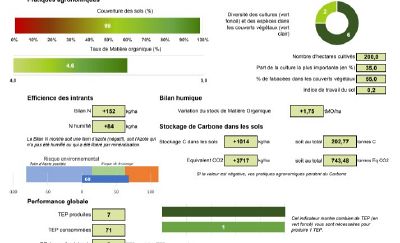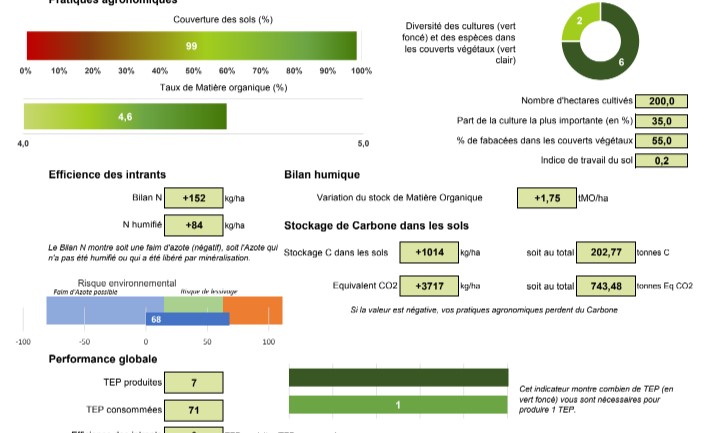Farm diagnosis and performance
 Humic balances, financial analysis, performance measurement, monitoring indicators, systemic analysis, IFT, ...
Humic balances, financial analysis, performance measurement, monitoring indicators, systemic analysis, IFT, ...

There are a number of agro-ecological evaluation tools available, designed to objectively measure the various aspects of a farm's or plot's performance. Some need to be accompanied by an expert, while others are designed to be reproduced from one year to the next to track changes, etc...
The Flower of Agroecology
Transparency of calculation depends on the tool used Measurement and entry by a third party ✔ Access to data (open data) ✘ Comparability of indicators (benchmark) depends on the tool used Areas for improvement by indicator ✔ Ergonomics ✔ Link Fermes d'Avenir website
- The Fleur de l'Agroécologie was created by Fermes d'AvenirFermes[1] in 2020-2021Fermes[2]
- It looks at the three pillars of sustainable development (Environment, Economy, Social), each assessed using four indicators.
- The summary presents tools for assessing these different indicators and the different levers that can be activated to improve the farm for each of them, whatever the agricultural production.
- This assessment system requires the support of an expert.
The regeneration index
Transparent calculation ✔ Measurement and entry by a third party ✔ Access to data (open data) ✔ Comparability of indicators (benchmark) ✔ Areas for improvement by indicator ✘ Ergonomics ✔ Link Regeneration index
- The Regeneration Index was created in 2021 as a result of close collaboration between the Scientific Committee and those working on the ground in the Living Agriculture movement. [3]
- This index has been built around 8 axes that enable the farm to be assessed at a systemic level, with a score out of 100: Soil cover, Tillage, Carbon cycle, Nitrogen fertilisation, Phytosanitary management, Biodiversity, Agroforestry, Training. It can be applied to all types of agricultural production.
- It is a free, open-source tool for assessing the agroecological level of farms.
- This assessment system requires the support of an expert.
DIALECTE
Calculation transparency ✔ Measurement and entry by a third party ✔ Access to data (open data) ✘ Comparability of indicators (benchmark) ✔ Areas for improvement by indicator ✘ Ergonomics ✘ Link Dialect website
- DIALECTE is an agri-environmental diagnostic toolDIALECTE:[4] //dialecte.solagro.org/index.php created and developed by SolagroSolagro:[5] since 1993.
- Quantitative analysis of 40 calculated agri-environmental indicators, supplemented by a qualitative analysis by the auditor for an overall environmental assessment. DIALECTE is applicable to all types of agricultural production.
- DIALECTE helps to identify strengths and weaknesses with regard to the 4 fundamental environmental themes: water, biodiversity, soil and consumption of non-renewable resources. Due to the age of the site, ergonomics are not necessarily optimal, but the site contains some very good resources.
- This evaluation system requires the support of an expert.
OASIS
Transparency of calculation NA Third party measurement and capture ✔ Access to data (open data) ✘ Comparability of indicators (benchmark) NA Areas for improvement by indicator NA Ergonomics ✔ Link PDF Oasis
- The Oasis projectAgroecology[6] has been developed by Agroecology EuropeAgroecology[7] in 2021.
- It assesses 5 dimensions based on the 13 principles of agroecology defined by FAOFAO[8] (agroecological practices, economic viability, social aspects, environment and biodiversity and resilience).
- OASIS aims to assess a farm at a given point in time, and then evaluate its progress towards a complete agro-ecological system through regular assessments during the transition. This involves contacting Agroecology Europe so that they can provide detailed assessment instructions for each indicator.
- This evaluation system requires the support of an expert.
DiagAgroEco
Transparent calculation ✔ Measurement and entry by a third party ✘ Access to data (open data) ✘ Comparability of indicators (benchmark) ✘ Areas for improvement by indicator ✔ Ergonomics ✔ Link DiagAgroEco website
- DiagAgroEcoDiagAgroEco:[9] //www.diagagroeco.org/ is an agroecological diagnostic tool created in 2015 by ACTA and the DGPE (Direction Générale de la Performance Economique et Environnementale des Entreprises).
- It is designed to help farmers reflect on their farm 's performance, practices and approaches, and to estimate their degree of commitment to agroecology.
- Farmers at can choose the modules of particular interest to them.For each practice, the site provides detailed technical data sheets.
- The assessment can be carried out as a self-diagnosis. The platform is highly intuitive.
Genesis
Calculation transparency ✔ Measurement and entry by a third party ✔ Access to data (open data) ✘ Comparability of indicators (benchmark) ✔ Areas for improvement by indicator ✔ Ergonomics ✔ Link Genesis website
- Genesis (aka Greenback) is a tool created in 2022 by Quentin [10] (ex Devialet). He brought together a multidisciplinary team of agronomists, soil experts, biologists, data engineers, programmers, designers and business developers to work on this index.
- Genesis is the first soil health rating system to integrate biodiversity, carbon and pollution diagnostics. Farmers can see the impact of their practices on the environment and their links with yields.
- The rating is based on 5 criteria, assessed using a total of 35 indicators, which are then aggregated into 5 areas: Biodiversity, Climate, Water, Soil, Fertility. The indicators are based on analyses carried out by partner laboratories.
- Genesis is free for farmers who agree to share their data, as the cost of the service is borne by third parties. Genesis helps farmers to contact their customers, cooperatives and partners so that they can access the ratings free of charge. The platform is highly intuitive.
IndicIADes
Transparency of calculation ✘ Measurement and entry by a third party ✔ Access to data (open data) ✘ Comparability of indicators (benchmark) ✔ Areas for improvement by indicator ✘ Ergonomics ✔ Link IndicIADes website
- IndicIADes [11] //www.carbonevert.fr/home is a tool created in 2008 by the Institut de l'Agriculture DurableThe[12]
- IndicIADes is a free diagnostic tool that identifies the strengths and weaknesses of a farm's agro-ecological transition.
- IndicIADes also provides a free assessment of the following calculations: GHG emissions, carbon balance, humic balance, agro-ecological project criteria.
- This tool is aimed at field crops, market gardening and viticulture.
- This assessment system requires the support of an expert.
Cool Farm Tool
IDEA4
Diagnosis HUMUS
CIVAM sustainability diagnosis
Diagnostic de durabilité CIVAM
CRATer
- CRATer is a regional food resilience calculator created by the association Les greniers d'Abondance.[13] The calculation methods are open to everyone.
- The site displays a dynamic map of France showing the evolution of the various issues in each of the départements. It also offers a more detailed food diagnosis for each region.
- The association's aim is to help raise awareness of the challenges of food resilience among a broad public (citizens, elected representatives, etc.) and to make it easier to carry out in-depth field diagnoses.
- A PDF Towards[14] is available, setting out the various levers that can be put in place at local level.
ClimAgri
- Created by ADEME, ClimAgri is a tool for diagnosing the energy consumption and greenhouse gas emissions of agriculture and forestry at regional level. A diagnosis shared by all stakeholders enables an objective analysis to be made of the challenges facing the region, priorities for action to be identified, simulations to be carried out and, finally, an action plan to be defined together.[15]
- ClimAgri is reserved for a small group of experts, not least because of the agronomic skills it requires. There is a two-day training course to get to grips with the tool, but a special request is necessary.
- ClimAgri runs in Excel.
- The results given are :
- Energy consumption (direct and indirect)
- Greenhouse gas emissions (direct and indirect)
- Carbon stock linked to agricultural and forest soils and forest biomass
- Production of agricultural and forestry raw materials
- Performance in feeding the region
Planet-ScorePlanet-Score[16]
Sources
- ↑ d'avenir: https://fermesdavenir.org/
- ↑ d'avenir, Synthèse du référentiel de la Fleur de l'Agroécologie: https://fermesdavenir.org/wp-content/uploads/2021/10/Fleur-de-lagroe%CC%81cologie_Livre-Blanc.pdf.
- ↑ Living Agriculture, The Regeneration Index: https://agricultureduvivant.org/indice-de-regeneration/
- ↑ http:
- ↑ https://solagro.org/index.php
- ↑ europe, OASIS: https://www.agroecology-europe.org/wp-content/uploads/2022/03/OASIS-20_01_digital_spreads.pdf
- ↑ Europe: https://www.agroecology-europe.org/
- ↑ , HLPE report, page 41 "Consolidated set of 13 agroecological principles":https://www.fao.org/3/ca5602en/ca5602en.pdf
- ↑ https:
- ↑ Sanniéhttps://www.lesechos.fr/weekend/business-story/environnement-quentin-sannie-apres-devialet-recit-dune-reconversion-1322431
- ↑ IndicIADes: https:
- ↑ Institut de l'Agriculture Durable: https://agridurable.top/.
- ↑ CRATer: https://crater.resiliencealimentaire.org/
- ↑ food resilience, CRATer: https://resiliencealimentaire.org/wp-content/uploads/2021/01/VersLaResilienceAlimentaire-DigitaleVersion-HD-1.pdf
- ↑ ClimAgri: https://expertises.ademe.fr/agriculture-foret/production-agricole/passer-a-laction/dossier/levaluation-environnementale-agriculture/loutil-climagri
- ↑ : https://www.planet-score.org/